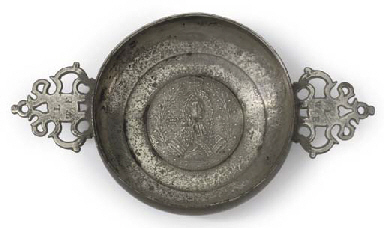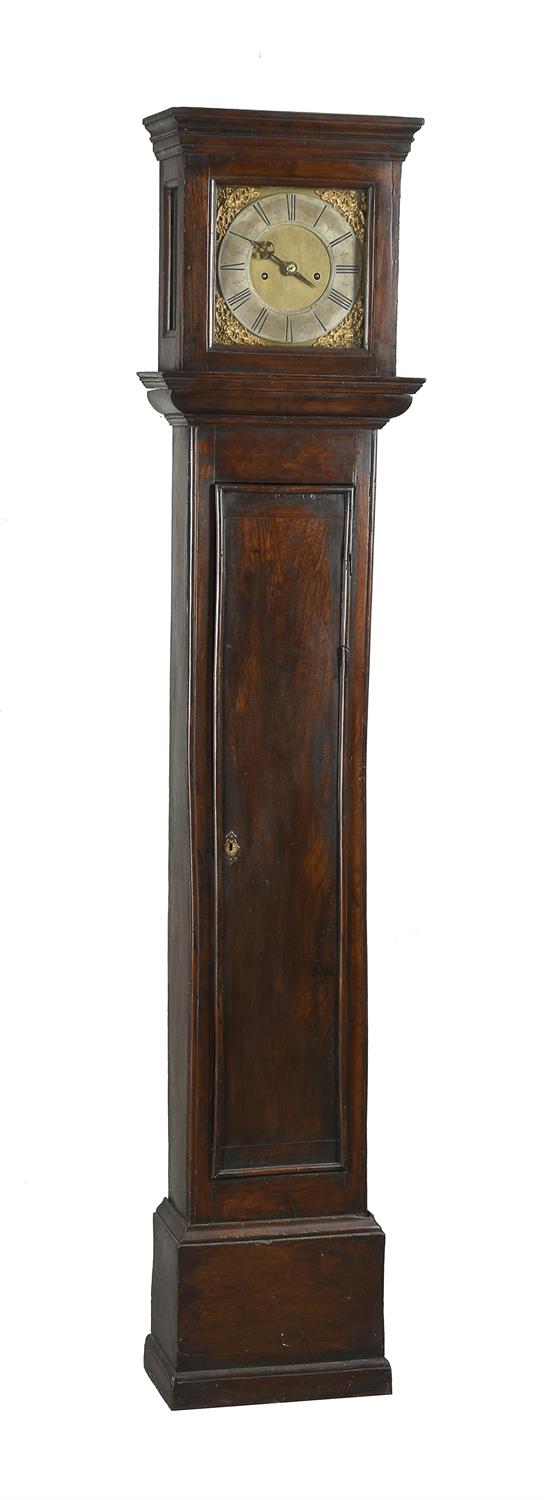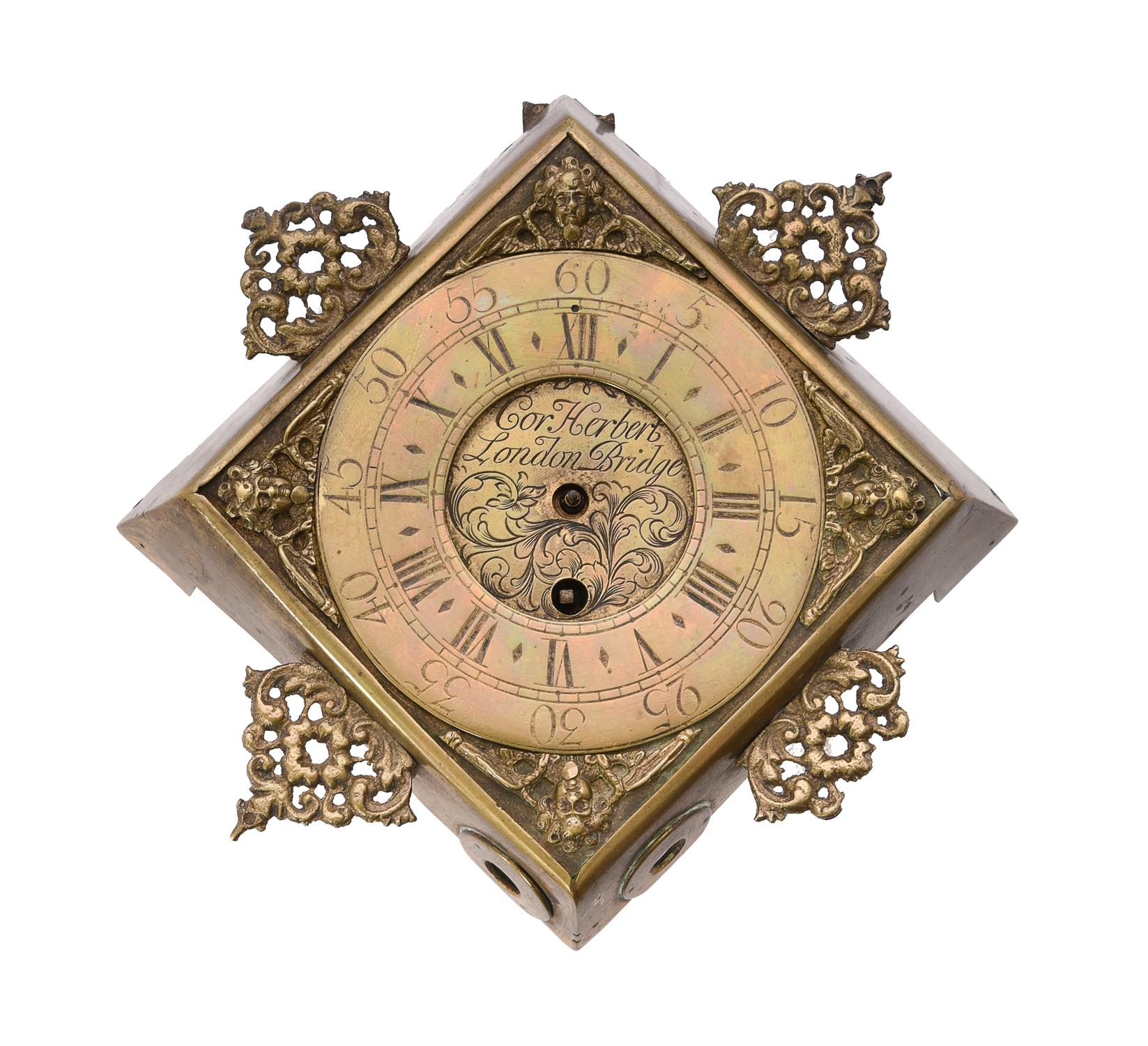A rare William III ebonised thirty-hour longcase clockKenyon, Liverpool circa 1690-95 The four finned pillar countwheel bell striking two-handed movement with anchor escapement and 9.75inch square brass dial with circular calendar aperture to the symmetrical tulip decorated foliate engraved centre incorporating unusual 'basket of bread' motif to upper margin and with ring turned centre aperture, within applied silvered Roman numeral chapter ring with stylised sword hilt half hour markers, Arabic five minutes to outer track and signed W'm Kenyon, Leverpoole to lower edge, with pierced steel hands and applied winged cherub head and scroll cast spandrels to angles, the case with ogee cornice and swollen frieze above three-quarter pilasters to the glazed hood door above convex throat and slender trunk with rectangular door, on comforming plinth base with moulded skirt, 203cm (80ins) high. Kenyon is recorded in Loomes, Brian LANCASHIRE CLOCKS and CLOCKMAKERS as believed born in 1667, Loomes further notes that various children, fathered by a William Kenyon, were born between the dates 1708-20. A James Kenyon is also recorded as working at Redcross Street in 1715 then Newmarket in 1725 and was declared insolvent in 1743. delicate light symmetrical arrangement of engraved foliate scrolls with large tulip blooms issuing from a central element towards the lower margin of the dial centre of the current lot is very similar in style and feel to the engraving to the dial centre of a lantern clock by John Barton of Aughton/Ormskirk illustrated in Loomes, Brian LANTERN CLOCKS & Their Makers page 303. As Loomes suggests that the lantern clock by Barton dates to the 1690's it would, on stylistic grounds, be reasonable to suggest that the current would date to the same decade. This date for the clock is perhaps further supported by the fact that Kenyon would have been of active working age at the start of the decade. As the cataloguer does not know of any other Liverpool-made clocks dating to before 1700 it would perhaps be reasonable to suggest that the current lot is possibly the earliest surviving clock to have been made in the city. IMPORTANT NOTES REGARDING THE CATALOGUING OF CLOCKS Movements, dials and cases: movements and dials are described as relating to the cases in which they are housed in one of the following three ways: the case.... we are of the opinion that the movement and dial started life in the current case. in a case... we are of the opinion that the movement and dial are in a case of correct period and type (and may well be original to the movement and dial), however there is evidence to suggest that they may not have started out life together. now in a case... we are of the opinion that the movement and dial are no longer in the original case or one of correct period and/or type. , weights, winding and case keys: we cannot guarantee that the correct number of weights (where appropriate) and/or keys are present with the clock, nor do we indicate in the catalogue description whether weights or keys are present as many clocks are consigned without them. Please check with the department to establish whether they are present or not prior to bidding. : due to the mechanical nature of clocks and the fact that most are of great age we cannot offer any guarantee as to whether they are in working order or free from major faults or restoration. Although we endeavour to catalogue items in a fair and informed manner, omission of any comments or observations regarding the condition or originality of a clock in the description does not necessarily indicate that it is free from significant faults, restoration or is in working condition. We would strongly advise any prospective purchaser to view the item in person or request a condition report and/or further images prior to bidding. : dial measurements are given in inches, other dimensions such as height are given in centimetres (and inches for English clocks). The measurement given for the
A rare William III ebonised thirty-hour longcase clockKenyon, Liverpool circa 1690-95 The four finned pillar countwheel bell striking two-handed movement with anchor escapement and 9.75inch square brass dial with circular calendar aperture to the symmetrical tulip decorated foliate engraved centre incorporating unusual 'basket of bread' motif to upper margin and with ring turned centre aperture, within applied silvered Roman numeral chapter ring with stylised sword hilt half hour markers, Arabic five minutes to outer track and signed W'm Kenyon, Leverpoole to lower edge, with pierced steel hands and applied winged cherub head and scroll cast spandrels to angles, the case with ogee cornice and swollen frieze above three-quarter pilasters to the glazed hood door above convex throat and slender trunk with rectangular door, on comforming plinth base with moulded skirt, 203cm (80ins) high. Kenyon is recorded in Loomes, Brian LANCASHIRE CLOCKS and CLOCKMAKERS as believed born in 1667, Loomes further notes that various children, fathered by a William Kenyon, were born between the dates 1708-20. A James Kenyon is also recorded as working at Redcross Street in 1715 then Newmarket in 1725 and was declared insolvent in 1743. delicate light symmetrical arrangement of engraved foliate scrolls with large tulip blooms issuing from a central element towards the lower margin of the dial centre of the current lot is very similar in style and feel to the engraving to the dial centre of a lantern clock by John Barton of Aughton/Ormskirk illustrated in Loomes, Brian LANTERN CLOCKS & Their Makers page 303. As Loomes suggests that the lantern clock by Barton dates to the 1690's it would, on stylistic grounds, be reasonable to suggest that the current would date to the same decade. This date for the clock is perhaps further supported by the fact that Kenyon would have been of active working age at the start of the decade. As the cataloguer does not know of any other Liverpool-made clocks dating to before 1700 it would perhaps be reasonable to suggest that the current lot is possibly the earliest surviving clock to have been made in the city. IMPORTANT NOTES REGARDING THE CATALOGUING OF CLOCKS Movements, dials and cases: movements and dials are described as relating to the cases in which they are housed in one of the following three ways: the case.... we are of the opinion that the movement and dial started life in the current case. in a case... we are of the opinion that the movement and dial are in a case of correct period and type (and may well be original to the movement and dial), however there is evidence to suggest that they may not have started out life together. now in a case... we are of the opinion that the movement and dial are no longer in the original case or one of correct period and/or type. , weights, winding and case keys: we cannot guarantee that the correct number of weights (where appropriate) and/or keys are present with the clock, nor do we indicate in the catalogue description whether weights or keys are present as many clocks are consigned without them. Please check with the department to establish whether they are present or not prior to bidding. : due to the mechanical nature of clocks and the fact that most are of great age we cannot offer any guarantee as to whether they are in working order or free from major faults or restoration. Although we endeavour to catalogue items in a fair and informed manner, omission of any comments or observations regarding the condition or originality of a clock in the description does not necessarily indicate that it is free from significant faults, restoration or is in working condition. We would strongly advise any prospective purchaser to view the item in person or request a condition report and/or further images prior to bidding. : dial measurements are given in inches, other dimensions such as height are given in centimetres (and inches for English clocks). The measurement given for the














Try LotSearch and its premium features for 7 days - without any costs!
Be notified automatically about new items in upcoming auctions.
Create an alert